Anasimyia interpuncta (Harris, 1776)
Identification
Identification difficulty = 4. ![]()
![]() according to Ball & Morris, 20241
according to Ball & Morris, 20241
Synonymy
This species was confused with A. lunulata before the review by Claussen & Torp (1980)2; older records are therefore suspect unless a specimen has been re-examined.
Biology
Many records are associated with beds of Reed Sweet Grass Glyceria maxima growing in ditches on grazing marsh or levels around large, lowland rivers and on coastal marshes. Adults have been found visiting yellow flowers, such as Marsh Marigold Caltha paulustris and other buttercups, close to such beds. Adults fly rather early in the year, in April to early May, but a smaller, second flight period sometimes occurs in July.
Flight period
The following plots show the number of unique records per week that were not reported to be of eggs, larvae or pupae.

Status
Lower Risk (Nationally scarce) - Ball & Morris, 20143. Rare (RDB3) - Falk, 19914. Vulnerable (RDB2) - Shirt, 19875.
Distribution
Mainly found in East Anglia, especially in the Norfolk Broads and the washes and flood plains of the main rivers such as the Nene and Great Ouse, but also in the Thames Marshes in Essex and the Pevensey Levels area of Sussex. It has recently been discovered in the Somerset Levels.

Trends
The following plots show the Frescalo TFactor vs year and a map of the rescaled frequency (all records) for the species. For an explanation see here.

-
Ball, S., & Morris, R. (2024). Hoverflies of Britain and Ireland. WILDGuides (3rd ed.). Oxford: Princeton University Press. ↩
-
Claussen, C., & Torp, E. (1980). Untersuchungen uber vier europaische Arten der Gattung Anasimyia Schiner, 1864 (Insecta, Diptera, Syrphidae). Mitt. zool. Mus. Univ. Kiel., 1(4), 1–11. ↩
-
Ball, S., & Morris, R. (2014). A review of the scarce and threatened flies of Great Britain. Part 6: Syrphidae. ( No. 9). Species status (pp. 1–130). Peterborough: JNCC. ↩
-
Falk, S. (1991). A review of the scarce and threatened flies of Great Britain. ( No. 39). Research and Survey in Nature Conservation (pp. 1–194). Peterborough: NCC. ↩
-
Shirt, D. (Ed.). (1987). Red Data Books: 2. Insects. Peterborough: NCC. ↩